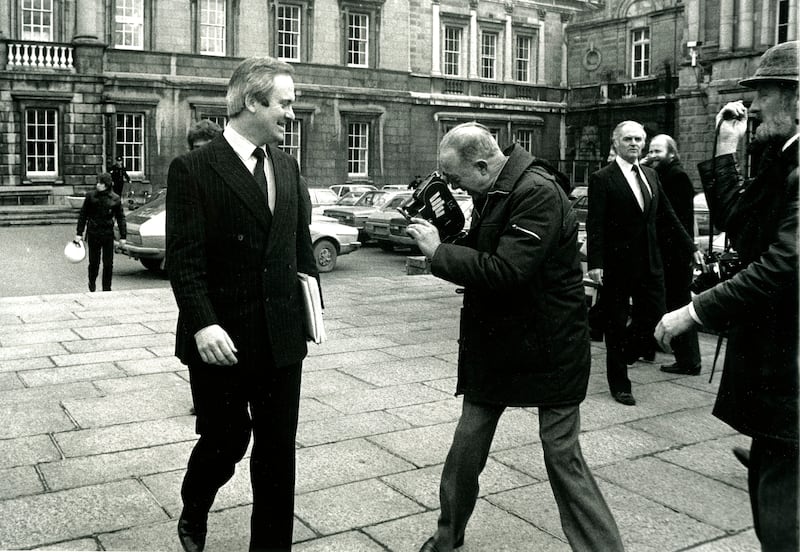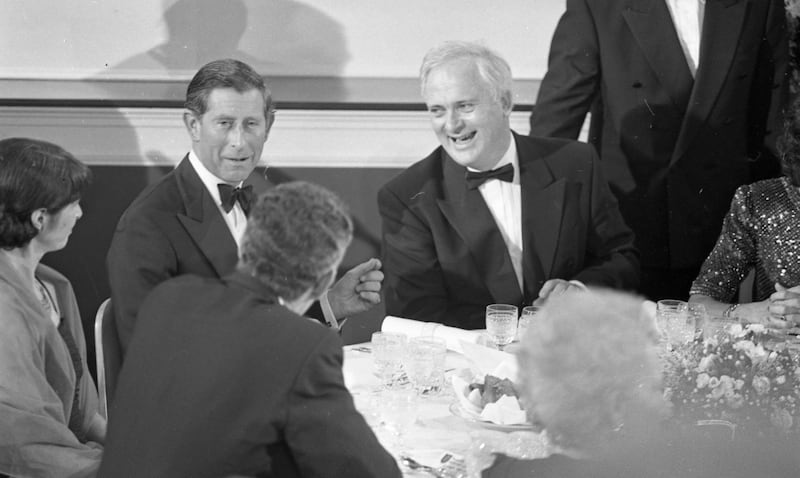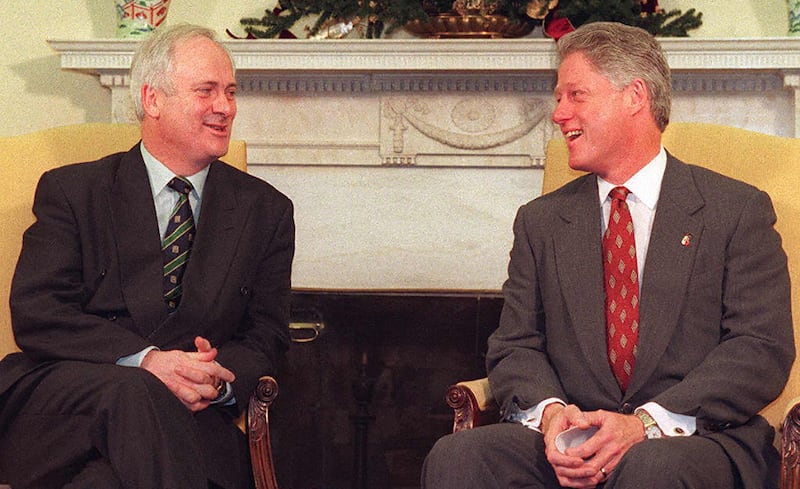Born: May 18th, 1947
Died: February 6th, 2024
John Bruton, who has died at the age of 76, was one of the leading politicians of his age who had the unique distinction of being the only person in the history of the State to become taoiseach because of a change of government without an election halfway through a Dáil term. He succeeded to the Taoiseach’s office in December 1994 when the Labour Party pulled out of government with Fianna Fáil and did a deal with Fine Gael to form a new administration rather than precipitating a general election.
Bruton was widely regarded as doing a good job as taoiseach between 1994 and 1997 but his rainbow coalition narrowly failed to win re-election in 1997. While he continued to lead Fine Gael for another four years, he was never to be taoiseach again. Bruton displayed great tenacity in fighting off two challenges to his leadership, the first in 1994, shortly before he became taoiseach and the second in 2000. He finally fell to the third challenge in 2001.
READ MORE
He left Irish politics to take up an appointment as European Union ambassador to the United States in 2002 and his reputation grew as his more successful political opponent Bertie Ahern left office mired in controversy in 2008. He always regarded himself as a representative of the Redmondite tradition in Irish politics, and he had a picture of the Irish Party leader on his wall during his time in the Taoiseach’s office.
He once recalled how his first question to the taoiseach as a young TD was to ask Jack Lynch if he intended to issue a commemorative stamp to the Irish Party leaders John Redmond, John Dillon and Joe Devlin, given that they were closer to his views than those of some Cabinet members. During the decade of centenaries from 1912 to 1922 he continued to champion Redmond’s constitutional approach to achieving Irish independence and made no secret of his view that the 1916 Rising and the violence that flowed from it was wrong and unnecessary.
Bruton’s open opposition to the physical force tradition in both the past and present often placed him at odds with mainstream nationalist opinion which has a more ambivalent attitude to the violence of the past, if not the present. While taoiseach, he was dubbed “John Unionist” and the label hurt politically.
During his period as taoiseach, Conor Cruise O’Brien remarked that “the Irish media don’t like him and have consistently underestimated him”, but he added that Bruton was “a person whose word is his bond”.

John Gerard Bruton was born on May 18th, 1947, into a comfortable farming family in Dunboyne, Co Meath. At a young age he was sent to boarding school at the elite Jesuit school, Clongowes Wood College.
After Clongowes he went on to University College Dublin, where he graduated with an honours degree in arts. After his BA he studied at the King’s Inns and qualified as a barrister but never practised at the bar.
Passionately interested in politics from an early age, he got an opportunity in 1969 to enter public life. His family were staunch supporters of Fine Gael but came from the minority Centre Party tradition within the party rather than the dominant Cumann na nGaedheal tradition.
[ Former taoiseach John Bruton dies following long illnessOpens in new window ]
He won a Fine Gael nomination and was elected to the Dáil for the Meath constituency at the age of just 22 ousting his party’s sitting TD, Denis Farrelly in the process. Bruton was one of the youngest people ever elected to Dáil Éireann.
He consolidated his position in the 1973 general election and was appointed as a parliamentary secretary, as junior ministers were then termed, by Liam Cosgrave who headed the Fine Gael-Labour coalition which held power from 1973 to 1977.
Bruton had huge admiration for Cosgrave and recalled in later years how after his first disastrous outing at parliamentary questions he received a phone call from the taoiseach. He was expecting a severe telling-off but instead Cosgrave reassured Bruton he had made a similar hash of his own first outing at Dáil questions and it was nothing to worry about.
After Fine Gael’s drubbing in the 1977 general election, Bruton was appointed by the new leader Garret FitzGerald as party spokesman on agriculture and two years later was promoted to be spokesman on finance.
By this stage he was one of the leading figures in Fine Gael and played a prominent role in the 1981 general election. He received a large vote in Meath, coming in with more than 3,000 votes over the quota on the first count. His enormous surplus helped to elect his running mate John Farrelly whose father Bruton had ousted in 1969.
Another Fine Gael-Labour coalition emerged with FitzGerald as taoiseach, although the government did not have a majority in the Dáil and depended on the support of a number of Independents for its survival.
At the age of just 34, he was appointed minister for finance and was immediately plunged into dealing with a crisis in the public finances which had developed out of the Fianna Fáil giveaway election manifesto of 1977.
It was exacerbated by a contrived set of public spending estimates for government departments devised by Charles Haughey’s government for 1981. When Bruton took over at finance he was told by officials that money for State spending would run out in the autumn unless a supplementary budget was introduced.

Faced with economic reality, he had to jettison Fine Gael election promises to cut taxes in that supplementary budget. He continued the retrenchment process alongside generous social welfare increases in the full-year budget for 1982 which he introduced in the Dáil in January of that year.
Objections to proposals to put VAT of 18 per cent on clothing and footwear, including children’s shoes tipped the balance against the budget, and it failed to pass, toppling the government. Fine Gael lost power in the subsequent election, but Haughey’s second government only lasted until November of 1982, when Fine Gael and Labour were returned to office.
Bruton was disappointed not to be reappointed to finance by FitzGerald and instead got industry and commerce. As the government struggled to get the public finances under control by relying on tax increases rather than spending cuts, Bruton was moved back to finance in 1986.
While he faced up to the need for spending cuts, the Labour Party ministers resisted them and signalled that they would withdraw from government rather than agree to the budget in January 1987. Bruton produced a tough budget measure and Fine Gael fought the election on it.
The party suffered a drubbing in the 1987 election and, ironically, the incoming Fianna Fáil minister for finance Ray MacSharry adopted Bruton’s budget and implemented it rigorously, thus paving the way for the economic recovery of the 1990s.
FitzGerald stood down as leader of Fine Gael and Bruton threw his hat into the ring for the leadership against the party’s elder statesman, Peter Barry, and Alan Dukes who had been his rival for the finance portfolio. Bruton was bitterly disappointed when Dukes emerged as the winner.
Dukes was regarded within Fine Gael as being closer to FitzGerald’s liberal vision of the party than Bruton who attracted support from the traditional wing of Fine Gael and identified with the European Christian Democrat tradition.
With Bruton’s support, Dukes backed the Fianna Fáil government’s approach to the public finances under the so-called “Tallaght Strategy”. However, Haughey pulled the plug on it in 1989 and called a snap general election. Fine Gael gained a small number of seats, but Haughey did a coalition deal with the Progressive Democrats (PDs).
When Fine Gael had a disastrous presidential election campaign in 1990 the parliamentary party turned against Dukes and looked to Bruton to take over. There was no contest this time around and he became party leader at the end of 1990.
He found it difficult to make an impact as Labour leader Dick Spring dominated the opposition to Haughey. The same pattern repeated itself when the coalition fell apart and a general election was held in November 1992.
It was a disastrous campaign for Bruton and Albert Reynolds. Spring seized the initiative and dominated the media coverage with blistering attacks on Reynolds. Instead of capitalising on the government’s unpopularity, Fine Gael lost another 10 seats.
The surprise outcome was that Labour concluded a coalition deal with Fianna Fáil. Poor poll results prompted a challenge to Bruton’s leadership in 1994, but he fought tenaciously and narrowly survived.
In the autumn of 1994, political fortune finally smiled on him as the Fianna Fáil-Labour government collapsed. It initially appeared that the most likely outcome would be a new deal between the parties with Ahern installed as taoiseach, but Bruton furiously denounced the proposed arrangement and it fell apart at the last minute.
Fine Gael, the Labour Party and the Democratic Left took the opportunity to strike a deal for government and Bruton was elected taoiseach on December 14th, 1994, at the head of what was termed the rainbow coalition. It was the only time a new government has taken office without a general election.
Bruton proved to be a much better taoiseach than leader of the opposition and he quickly confounded his many critics in the political world and the media who had forecast that he would not have the required skills to keep a three-party coalition going.
The economy performed well under the rainbow government and it also had a notable success in having the ban on divorce removed from the Constitution. Bruton was perceived as having conservative views on social issues, but he threw himself into the divorce campaign and was credited with swinging the vote with a last-minute appeal to the country.
On Northern Ireland, he had little natural sympathy with the Sinn Féin position but continued the process initiated by Reynolds. In negotiations with the British, he agreed the framework documents which were a significant milestone on the way to the Belfast Agreement.

Bruton presided over the first official visit to the State by a member of the British royal family when Prince Charles visited the country in 1995 and was guest of honour at a State dinner in Dublin Castle.
He had a greater understanding of the unionist position than most politicians in the Republic and for that was dubbed “John Unionist” by Reynolds. His impatience with constant questioning by journalists about the North got the better of him on one occasion when he told a local radio reporter he was tired being asked about “the f**king peace process”.
The decision of the Provisional IRA to break the ceasefire of 1996 by planting a bomb at Canary Wharf in London was a setback for the government. It was followed by the IRA murder of Sgt Jerry McCabe in Co Limerick which further soured relations between the government and Sinn Féin.
Economic progress and a successful presidency of the European Union outweighed the setbacks and the government appeared in good shape when Bruton dissolved the Dáil and in May 1997. In a closely fought campaign the alternative coalition of Fianna Fáil and the PDs emerged with marginally more seats but failed to get an overall majority.
The rainbow government lost office mainly due to the collapse of the Labour vote, with the party losing half the seats it had obtained in 1992. Fine Gael gained nine seats, but it was not enough to save the coalition.
[ John Bruton: A life in picturesOpens in new window ]
Back in opposition, Bruton again began to struggle and when polls showed the government’s popularity on the increase the mood in the parliamentary party turned against him. He fought off one heave in 2000 but succumbed to another in 2001 when he was replaced as leader by Michael Noonan.
In the event, Noonan led Fine Gael to election disaster in 2002. Bruton was re-elected to the Dáil, but in 2004 he was offered and accepted the position of European Union ambassador to the United States. He had served a successful term in that position, giving the EU a much higher profile on Capitol Hill than any of his predecessors.

On his return to Ireland he continued to engage in public life, writing and speaking about issues of interest particularly in relation to 20th century Irish history and the future of the EU.
He was appointed chairman of the newly formed financial services body IFSC Ireland with the job of promoting the country as a location for international financial services. He also served as chairman of Co-operation Ireland which aims to promote good relations between the two communities in the North and between North and South.
Bruton declined an approach from Fine Gael to stand as the party’s candidate in the 2001 presidential election. During the decade of centenaries he continued to promote the cause of Redmond and constitutional nationalism. In September 2014, on the centenary of the Home Rule Bill, he reiterated his view that the 1916 Rising was a mistake.
A strong supporter of the EU throughout his political life, he took a leading role in the debate about how Ireland should respond to Brexit. Along with Ahern, he gave evidence to the House of Lords in London about the implications of Brexit and pointed out the damage the imposition of a hard border on the island of Ireland would do to the Belfast Agreement.
He is survived by his wife Finola, son Matthew and daughters Juliana, Emily and Mary-Elizabeth, grandchildren, sons-in-law, his brother, Richard and sister, Mary, nieces, nephews, many cousins and extended family.









